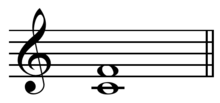
Back Puhas kvart ET چهارم درست FA Quarte (musique)#Quarte juste French Hrein ferund IS Quarta giusta Italian 完全四度 Japanese Čista kvarta SL 純四度 Chinese 純四度 ZH-YUE

| Inverse | perfect fifth |
|---|---|
| Name | |
| Other names | diatessaron |
| Abbreviation | P4 |
| Size | |
| Semitones | 5 |
| Interval class | 5 |
| Just interval | 4:3 |
| Cents | |
| 12-Tone equal temperament | 500 |
| Just intonation | 498 |
A fourth is a musical interval encompassing four staff positions in the music notation of Western culture, and a perfect fourth (ⓘ) is the fourth spanning five semitones (half steps, or half tones). For example, the ascending interval from C to the next F is a perfect fourth, because the note F is the fifth semitone above C, and there are four staff positions between C and F. Diminished and augmented fourths span the same number of staff positions, but consist of a different number of semitones (four and six, respectively).
The perfect fourth may be derived from the harmonic series as the interval between the third and fourth harmonics. The term perfect identifies this interval as belonging to the group of perfect intervals, so called because they are neither major nor minor.
A perfect fourth in just intonation corresponds to a pitch ratio of 4:3, or about 498 cents (ⓘ), while in equal temperament a perfect fourth is equal to five semitones, or 500 cents (see additive synthesis).
Until the late 19th century, the perfect fourth was often called by its Greek name, diatessaron.[1] Its most common occurrence is between the fifth and upper root of all major and minor triads and their extensions.
An example of a perfect fourth is the beginning of the "Bridal Chorus" from Wagner's Lohengrin ("Treulich geführt", the colloquially-titled "Here Comes the Bride"). Another example is the beginning melody of the State Anthem of the Soviet Union. Other examples are the first two notes of the Christmas carol "Hark! The Herald Angels Sing" and "El Cóndor Pasa", and, for a descending perfect fourth, the second and third notes of "O Come All Ye Faithful".[citation needed]
The perfect fourth is a perfect interval like the unison, octave, and perfect fifth, and it is a sensory consonance. In common practice harmony, however, it is considered a stylistic dissonance in certain contexts, namely in two-voice textures and whenever it occurs "above the bass in chords with three or more notes".[2] If the bass note also happens to be the chord's root, the interval's upper note almost always temporarily displaces the third of any chord, and, in the terminology used in popular music, is then called a suspended fourth.
Conventionally, adjacent strings of the double bass and of the bass guitar are a perfect fourth apart when unstopped, as are all pairs but one of adjacent guitar strings under standard guitar tuning. Sets of tom-tom drums are also commonly tuned in perfect fourths. The 4:3 just perfect fourth arises in the C major scale between F and C.[3] ⓘ
- ^ William Smith and Samuel Cheetham (1875). A Dictionary of Christian Antiquities. London: John Murray. ISBN 9780790582290.
- ^ Sean Ferguson and Richard Parncutt. "Composing in the Flesh: Perceptually-Informed Harmonic Syntax" (PDF). Archived from the original (PDF) on 2005-10-13. Retrieved 2006-09-05.
{{cite journal}}: Cite journal requires|journal=(help) - ^ Paul, Oscar (1885). A manual of harmony for use in music-schools and seminaries and for self-instruction, p.165. Theodore Baker, trans. G. Schirmer.
